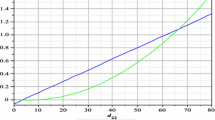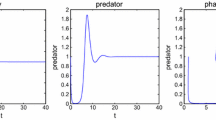Abstract
In the present work, we have studied a diffusive tritrophic food chain model in which the species at each trophic level interact in accordance with Crowley–Martin functional response under mixed boundary conditions. Using degree theory and fixed point index-based methods, we have proved the existence of the positive solutions of the proposed system. We have proved the permanence of the positive solutions and existence of global attractor. The conditions for diffusion-driven instability have been obtained analytically. Moreover, the pattern formation due to diffusion-driven instability has been investigated numerically. We have shown the existence of the positive solutions both analytically and numerically.


Similar content being viewed by others
References
Turing, A.M.: The chemical basis of morphogenesis. Philos. Trans. R. Soc. Lond. B Biol. Sci. 237(641), 37–72 (1952)
Iron, D., Ward, M.J., Wei, J.: The stability of spike solutions to the one-dimensional Gierer–Meinhardt model. Physica D 150(1–2), 25–62 (2001)
Davidson, F.A., Rynne, B.P.: A priori bounds and global existence of solutions of the steady-state Sel’kov model. Proc. R. Soc. Edinb. Sect. A Math. 130(3), 507–516 (2000)
Lin, C.-S., Ni, W.-M., Takagi, I.: Large amplitude stationary solutions to a chemotaxis system. J. Differ. Equ. 72(1), 1–27 (1988)
Zhou, J., Chunlai, M.: Pattern formation of a coupled two-cell Brusselator model. J. Math. Anal. Appl. 366(2), 679–693 (2010)
Kondo, S.: The reaction–diffusion system: a mechanism for autonomous pattern formation in the animal skin. Genes Cells 7(6), 535–541 (2002)
Kondo, S., Miura, T.: Reaction–diffusion model as a framework for understanding biological pattern formation. Science 329(5999), 1616–1620 (2010)
Dubey, B., Kumari, N., Upadhyay, R.K.: Spatiotemporal pattern formation in a diffusive predator–prey system: an analytical approach. J. Appl. Math. Comput. 31(1–2), 413–432 (2009)
Kumari, N.: Pattern formation in spatially extended tritrophic food chain model systems: generalist versus specialist top predator. ISRN Biomath. 2013, 198185 (2013)
Tang, X., Song, Y., Zhang, T.: Turing-Hopf bifurcation analysis of a predator–prey model with herd behavior and cross-diffusion. Nonlinear Dyn. 86(1), 73–89 (2016)
Sun, G.-Q.: Mathematical modeling of population dynamics with Allee effect. Nonlinear Dyn. 85(1), 1–12 (2016)
Sun, G.-Q., et al.: Influence of isolation degree of spatial patterns on persistence of populations. Nonlinear Dyn. 83(1–2), 811–819 (2016)
Sun, G.-Q., et al.: Pattern transitions in spatial epidemics: mechanisms and emergent properties. Phys. Life Rev. 19, 43–73 (2016)
Wang, T.: Pattern dynamics of an epidemic model with nonlinear incidence rate. Nonlinear Dyn. 77(1–2), 31–40 (2014)
Skalski, G.T., Gilliam, J.F.: Functional responses with predator interference: viable alternatives to the Holling type II model. Ecology 82(11), 3083–3092 (2001)
Cantrell, R.S., Cosner, C.: On the dynamics of predator–prey models with the Beddington–DeAngelis functional response. J. Math. Anal. Appl. 257(1), 206–222 (2001)
Crowley, P.H., Martin, E.K.: Functional responses and interference within and between year classes of a dragonfly population. J. N. Am. Benthol. Soc. 8(3), 211–221 (1989)
Upadhyay, R.K., Naji, R.K.: Dynamics of a three species food chain model with Crowley–Martin type functional response. Chaos Solitons Fract. 42(3), 1337–1346 (2009)
Dong, Y., et al.: Qualitative analysis of a predator–prey model with Crowley–Martin functional response. Int. J. Bifurcat. Chaos 25(09), 1550110 (2015)
Tiwari, V., Tripathi, J.P., Abbas, S., Wang, J.-S., Sun, G.-Q., Jin, Z.: Qualitative analysis of a diffusive Crowley–Martin predator–prey model: the role of nonlinear predator harvesting. Nonlinear Dyn. 98(2), 1169–1189 (2019)
Dancer, E.N.: On the indices of fixed points of mappings in cones and applications. J. Math. Anal. Appl. 91(1), 131–151 (1983)
Dancer, E.N., Yihong, D.: Positive solutions for a three-species competition system with diffusion—I. General existence results. Nonlinear Anal. Theory Methods Appl. 24(3), 337–357 (1995)
Dancer, E.N.: On positive solutions of some pairs of differential equations. Trans. Am. Math. Soc. 284(2), 729–743 (1984)
Dancer, E.N.: On positive solutions of some pairs of differential equations. II. J. Differ. Equ. 60(2), 236–258 (1985)
Zhou, J., Chunlai, M.: Positive solutions for a three-trophic food chain model with diffusion and Beddington–Deangelis functional response. Nonlinear Anal. Real World Appl. 12(2), 902–917 (2011)
Yamada, Y.: Positive solutions for Lotka–Volterra systems with cross-diffusion. In: Chipot, M. (ed.) Handbook of differential equations: stationary partial differential equations, vol. 6, pp. 411–501. Elsevier, North-Holland (2008)
Li, L.: Coexistence theorems of steady states for predator–prey interacting systems. Trans. Am. Math. Soc. 305(1), 143–166 (1988)
Cano-Casanova, S.: Existence and structure of the set of positive solutions of a general class of sublinear elliptic non-classical mixed boundary value problems. Nonlinear Anal. Theory Methods Appl. 49(3), 361–430 (2002)
Cano-Casanova, S., López-Gómez, J.: Properties of the principal eigenvalues of a general class of non-classical mixed boundary value problems. J. Differ. Equ. 178(1), 123–211 (2002)
Pao, C.V.: Quasisolutions and global attractor of reaction–diffusion systems. Nonlinear Anal. Theory Methods Appl. 26(12), 1889–1903 (1996)
Chen, S.-J., et al.: Abundant exact solutions and interaction phenomena of the (2+ 1)-dimensional YTSF equation. Anal. Math. Phys. 9(4), 2329–2344 (2019)
Xu, H.-N., Ruan, W.-Y., Lü, X.: Multi-exponential wave solutions to two extended Jimbo–Miwa equations and the resonance behavior. Appl. Math. Lett. 99, 105976 (2020)
Hua, Y.-F., et al.: Interaction behavior associated with a generalized (2+ 1)-dimensional Hirota bilinear equation for nonlinear waves. Appl. Math. Model. 74, 184–198 (2019)
Lü, X., Ma, W.-X.: Study of lump dynamics based on a dimensionally reduced Hirota bilinear equation. Nonlinear Dyn. 85(2), 1217–1222 (2016)
Yin, Y.-H., et al.: Diversity of exact solutions to a (3+ 1)-dimensional nonlinear evolution equation and its reduction. Comput. Math. Appl. 76(6), 1275–1283 (2018)
Gao, L.-N., et al.: Bäcklund transformation, multiple wave solutions and lump solutions to a (3+ 1)-dimensional nonlinear evolution equation. Nonlinear Dyn. 89(3), 2233–2240 (2017)
Gao, L.-N., et al.: Resonant behavior of multiple wave solutions to a Hirota bilinear equation. Comput. Math. Appl. 72(5), 1225–1229 (2016)
Lü, X., Lin, F., Qi, F.: Analytical study on a two-dimensional Korteweg–de Vries model with bilinear representation, Bäcklund transformation and soliton solutions. Appl. Math. Model. 39(12), 3221–3226 (2015)
Shi, H.-B., Ruan, S.: Spatial, temporal and spatiotemporal patterns of diffusive predator–prey models with mutual interference. IMA J. Appl. Math. 80(5), 1534–1568 (2015)
Baurmann, M., Gross, T., Feudel, U.: Instabilities in spatially extended predator–prey systems: spatio-temporal patterns in the neighborhood of Turing–Hopf bifurcations. J. Theor. Biol. 245(2), 220–229 (2007)
Alonso, D., Bartumeus, F., Catalan, J.: Mutual interference between predators can give rise to Turing spatial patterns. Ecology 83(1), 28–34 (2002)
Cantrell, R.S., Cosner, C.: Spatial Ecology via Reaction–Diffusion Equations. Wiley, Hoboken (2004)
Deimling, K.: Nonlinear Functional Analysis. Courier Corporation, North Chelmsford (2010)
Krasnoselskii, M.A.: Positive Solutions of Operator Equations. P. Noordhoff, Groningen (1964). English translation of Russian original
Pao, C.-V.: Nonlinear Parabolic and Elliptic Equations. Springer, Cham (2012)
Kumari, N., Mohan, N.: Cross diffusion induced turing patterns in a tritrophic food chain model with Crowley–Martin functional response. Mathematics 7(3), 229 (2019)
Cao, X., Jiang, W.: Turing–Hopf bifurcation and spatiotemporal patterns in a diffusive predator–prey system with Crowley–Martin functional response. Nonlinear Anal. Real World Appl. 43, 428–450 (2018)
Jia, Y.: Computational analysis on Hopf bifurcation and stability for a consumer-resource model with nonlinear functional response. Nonlinear Dyn. 94(1), 185–195 (2018)
Upadhyay, R.K., Pal, A.K., Kumari, S., Roy, P.: Dynamics of an SEIR epidemic model with nonlinear incidence and treatment rates. Nonlinear Dyn. 96(4), 2351–2368 (2019)
Fasani, S., Rinaldi, S.: Remarks on cannibalism and pattern formation in spatially extended prey–predator systems. Nonlinear Dyn. 67(4), 2543–2548 (2012)
Hu, G., Li, X., Wang, Y.: Pattern formation and spatiotemporal chaos in a reaction–diffusion predator–prey system. Nonlinear Dyn. 81(1–2), 265–275 (2015)
Acknowledgements
We would like to thank the editor and the anonymous reviewers whose comments and suggestions have immensely helped us to improve the quality of the paper. The first author (NK) is also thankful to Science Engineering Research Board (SERB), India, for providing financial support under two separate grants with Grant Numbers MTR/2018/000727 and EMR/2017/005203.
Author information
Authors and Affiliations
Corresponding author
Ethics declarations
Conflict of interest
The authors declare that there is no conflict of interests regarding the publication of this article.
Ethical standard
The authors state that this research complies with ethical standards. This research does not involve either human participants or animals.
Additional information
Publisher's Note
Springer Nature remains neutral with regard to jurisdictional claims in published maps and institutional affiliations.
Rights and permissions
About this article
Cite this article
Kumari, N., Mohan, N. Positive solutions and pattern formation in a diffusive tritrophic system with Crowley–Martin functional response. Nonlinear Dyn 100, 763–784 (2020). https://doi.org/10.1007/s11071-020-05534-5
Received:
Accepted:
Published:
Issue Date:
DOI: https://doi.org/10.1007/s11071-020-05534-5




